The Best Splitboard Gear of 2023
This article originally appeared on Outside
Nothing kills the powder-day stoke like a three-hour lift line. Splitboard gear is a ticket away from the land of lift tickets, powder panic, and overpriced bread bowls. The only limits on a splitter are self-imposed: how far are you willing to hike? How many blisters will you endure for blower? And do you have the avalanche safety knowledge, alpine acumen, and snowboard skills to make it home unscathed?
Of course, there are financial limitations, too. Splitting ain't cheap. Nor is the snow safety gear or the avalanche training courses you'll need to practice the sport responsibly. But look at it this way: the best splitboard gear and an AIARE Level 1 course is much cheaper than a heli trip, and unlike that single-use spike of adrenaline, the split is a gift that keeps on ripping for years to come. And, if you are boarding on budget, you'll be stoked to find a split below that clocks in at $599-less than many of the solid boards we tested this winter.
Read more: The Best Snowboards of 2023
How We Test
Number of testers: 20
Number of splitboards tested: 20
States where we tested: California, Nevada, Utah, Alaska, Washington, Wyoming
Longest day: A 13-hour mission in the Eastern Sierra
Most Tester Backcountry Overnights: 30
Most Tester Vert in a Day: 9,247 feet
Hardbooters: Two
Splits Snapped: One
Torn Meniscus: One
Cases of Fat Tire: 18
Our splitboard and snowboard gear testing this past winter culminated with a five-day, 20-tester marathon of board analysis at Sugar Bowl in mid-April. A lesser-known gem perched high on Tahoe's Donner Summit, the modest mountain is charmingly independent, virtually free of lift lines, and provides access to some of the Sierra's finest freeride and sidecountry terrain, making it a primo location to get testers on backcountry gear.
Our test week was blessed with the range of conditions we expect to come across in an entire season in the backcountry: low-tide corn, springy slush, teeth-chattering refreeze, shallow powder, bottomless blower--you name it. Conditions were so mouthwateringly deep by the end of the week that a handful of testers stayed for an extra day, unable to tear themselves away from the late-season shred fest.
Still, it's tough to orchestrate a backcountry test entirely in bounds, and while we use our week at Sugar Bowl as an opportunity to get a variety of riders on boards, bindings, and more, we made sure to spend time in the field assessing boards' strengths, weaknesses, and durability over the months leading up to the test and those that follow. All season long, we had select veteran testers putting splitboard gear to the test on the skintrack. These testers range from gear nerds in the Cascades to guides in the High Sierra.
Once the snow melts, I--our test director--cross reference test forms from Sugar Bowl against in-depth feedback from our long-term field testers, and compile the reviews you'll read below.
Want to round out your kit with new boots, bindings, or accessories? Check out those reviews here.
Meet Our Testers
Drew Zieff
Drew Zieff is a Tahoe-based freelance writer and a lifelong snowboarder. In addition to directing Outside Magazine's snowboard and splitboard gear tests--a role he's handled since 2016--he directs Backcountry Magazine's splitboard test, waxes on the Natural Selection and snowboard culture for Whitelines Snowboarding, and nerds out on snowboard gear and travel for REI, Gear Junkie, Gear Patrol, and Popular Mechanics, among others. He spends his winters testing snowboard and splitboard gear in his backyard backcountry zones or up at Palisades, as well as chasing stories and storms to snowboard meccas like Alaska and Wyoming, British Columbia and Japan. His summers? They're mainly spent at his desk, sifting through review forms and spec sheets, compiling our snowboard reviews--although he occasionally disappears in his custom-built 2006 Chevy Express for a few days when there's swell on the coast.
John Lauer
A longtime member of the Outside Magazine test team, hardboot splitboarder, and all-mountain charger, John Lauer is a snowboard buyer and boot fitter for Truckee gear shop Tahoe Sports Hub. When the consummate gear nerd isn't slanging snowboards, sending gnar at Palisades, or splitboarding in his backyard Sierras, you might find Lauer tinkering with his custom-built hardboot setup--a subject he's written about in detail for Backcountry Magazine.
Chris Cloyd
The only thing more eclectic than Chris Cloyd's riding style is his resume. A former touring musician, personal trainer, cyclist, and endurance athlete who lives in June Lake, CA, Chris Cloyd spends his winters snowboard guiding at High Sierra Snowcat and Yurt and his summers hut-keeping at Frog Lake Backcountry Huts. When he's not driving--and herding--cats in the backcountry, you can find him crushing couloirs deep in the Eastern Sierras or putting solid boards through their paces at Mammoth. A fan of strong coffee and heavy metal who often combines the two on his way to board, Cloyd is not remotely gentle on his gear--he lives to thrash.
Theresa Clinton
Theresa "Tree" Clinton has deep roots in snowboarding. The Whistler-based ripper and realtor spent a decade marketing boards for Canadian powder powerhouse Prior snowboards before working for a number of snowboard tour companies, both on the operations side of things and as a guide in the field. While her snowboard travels have taken her to Chile and New Zealand, Japan and all over the U.S., she has a soft spot in her heart for British Columbian pillows and powder. Fit, fast, and a total board nerd, Tree's been an instrumental member of our test team.
Claire Lawrenson
Claire Lawrenson is an artist on and off the hill. An exceptionally talented watercolorist, Lawrenson's depictions of her Tahoe backyard are nothing short of stellar, and she runs watercolor workshops in addition to peddling her own paintings. She's a coach when the snow falls, too, teaching young snowboarders to progress safely and stylishly. When she's off the clock, she puts her money where her mouth is, ripping resort and backcountry alike with bulletproof fundamentals and artistic flair.
Reviews: The Best Splitboards of 2023
Lib Tech Orca Split ($1200)
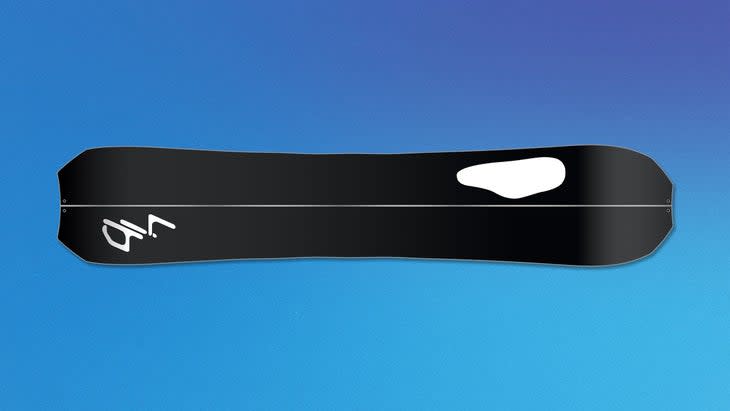
Weight: 7.1 lbs. (156cm)
Sizes: 150cm, 153cm, 156cm, 159cm
Shape: Directional
Profile: C2x (camber-rocker-camber)
Waist Width: 26.5cm (156cm)
Sidecut: 8m (156)
Stiffness Rating: 7/10 (150cm) 8/10 (153cm-159cm)
Pros:
Versatile split that crushes everything from couloirs to pillow lines
No need for a split quiver
Well-balanced combination of float, edge hold, agility, stability, pop, and response
Cons:
The lack of full-wrap edges on nose and tail can lead to durability issues when skinning or storing
The combination of no full-wrap edges and a funky tail shape necessitates care when selecting and trimming skins
Rocker can minimize edgehold on sketchy skin tracks
After watching Travis Rice take down his backcountry-freestyle Natural Selection tour this past spring, we came to a realization: if you want to be the G.O.A.T., ride an Orca. But Lib Tech has a veritable pod of them on the market right now, so the question is, which Orca? Ostensibly, the Orca Split is an uphill-friendly version of T. Rice's original Orca, which we gave top honors to when it first dropped in '18-'19. However, in reality, its specs are closer to those of the Golden Orca--the newer backcountry-freestyle blade that Rice relies on when competing at Natural Selection stops in Jackson Hole, British Columbia, and Alaska. The Golden Orca impressed testers at our all-conditions Sugar Bowl test last season: it's a narrower, more drawn-out, freestyle-friendly spinoff of the OG Orca, and it rips the resort, pops well, and excels at backcountry freestyle. But we're not here to talk solids--we're here to make split decisions.
Lib Tech built the Orca Split around a lightweight aspen and paulownia core with birch internal sidewalls, wrapped it in tri- and bi-ax fiberglass, and sandwiched it between an eco-resin topsheet and a speedy, sintered base. The resulting flex is "middle of the road," according to one tester. "It's stiff enough to slam the gas in steep terrain and malleable enough to throw endless butters and pop natural threes." Lib's proprietary Magne-Traction--serrated bumps along the sidecut--help the Orca Split lock in on sketchy traverses or unexpected, mid-line hardpack, although some purists who prefer smooth sidecuts do find the bumps grabby.
A C2x hybrid camber-rocker-camber profile sports a pronounced pocket of rocker between the bindings, which is understandably controversial amongst the splitboard crowd. Most splitters appreciate the flex and bite of camber underfoot when skinning beat-to-crap skin tracks and sidehilling firm snow. But testers felt that superb downhill ride quality was worth a near-negligible disadvantage on the uphill. One tester called out this board's intuitive feel on the descent. "It rides just like a solid and does everything I ask, from holding high-speed straight lines to boosting cross-court ollies and bouncing through pillow fields," he said. "You step on the back foot and the rocker lifts the nose like a plastic surgeon." Is its uphill performance better than the rest? No. But this tester admitted that there were only a few times when he craved a full camber on the way up. For that, there's an easy solution: split crampons, which every backcountry snowboarder should be carrying anyway.
The bigger tradeoff wound up being the lack of full-wrap edges along the nose and tail. "Splitboards take a beating, and it'd be nice to have a wrapped edge for durability's sake," commented a rider who otherwise loved the Orca Split. "The tip and tail are lightweight for spinning and skinning, but I'd take more durability any day."
Note: we recommend sizing down, but not as much as we've suggested for the regular Orca, because the split is a narrower board. One tester who normally rides a 158 to 160 split--and a 153 solid Orca--found the 156 to be his sweet spot in the Orca Split.
Best for: Intermediate and up riders who want a Swiss Arm Knife split that can bite into hardpack, float effortlessly through powder, rail turns at speed, and inject freestyle into every backcountry line. Also suited for anyone who wants to pretend they're Travis Rice but doesn't have a Red Bull heli budget and has to rely on hamstrings instead.
Weston Revel Split ($949)
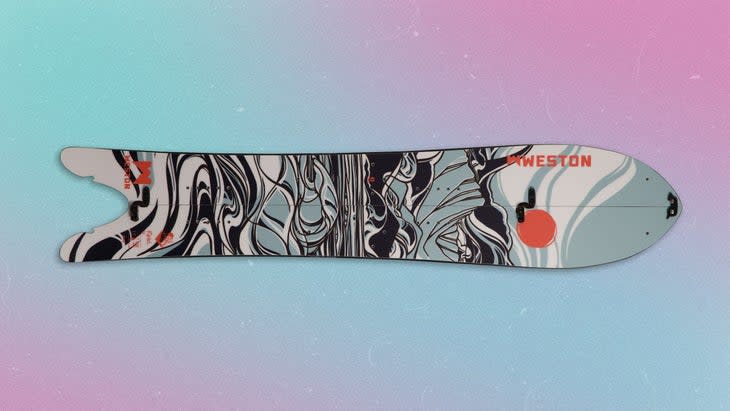
Weight: 6.5 lbs. (153cm)
Sizes: 143cm, 148cm, 153cm
Shape: Swallowtail
Profile: Powder (rockered nose, slight camber underfoot)
Waist Width: 25.6cm (153cm)
Sidecut: 8.7/6.6m (153cm)
Stiffness Rating: 5/10
Pros:
Hokkaido-ready float and a hardpack-hacking sidecut make for a multi talented split
Testers that rode both split and solid versions commented on a similar ride feel--a nod to Weston's split construction
In 2023, Weston is launching custom-cut skins. The Revel's sport tail clips that lock into notches on the swallowtail wings for fast, painless transitions
Cons:
Some testers were surprised by the swallowtail's pop, while others claimed it should stay on the ground
We're fans of Weston's swallowtails around here: we awarded the men's Japow solid Gear of the Year in 2018. The Revel is a new women's-specific shape based on that award winner. Available in both split and solid, the Revel shares the Japow's powder-hungry, trench-laying camber profile--slight camber through the bulk of the board, flowing into a rockered nose--and versatile, rippable sidecut. However, per requests from Weston's female riders like guides Sarah MacGregor and Kiira Antenucci who found the 154 Japow tough to drive through tighter trees, Weston's designers compressed the proven design, giving the Revel a relatively shorter nose and shallower swallowtail. Weston claims the tweaked shape boosts the Revel's agility in deep snow, and according to our crew who put the Revel to the test in season-highlight storms in the Sierra, the new shape performs as intended: it's a versatile, smile-inducing carve connoisseur ready to wiggle through powder-cloaked trees from the pines in Tahoe to the aspens in Weston's own Colorado and the white birch in the land of the rising sun.
"When put on edge, the Revel locks into turns. It's swift edge to edge and offers a lot of play off the swallowtail," wrote a banked slalom regular. Sustainably-sourced poplar and paulownia give the Revel a snappy and reliable backbone, while carbon stringers bolster the tail, encouraging "nimble and zippy turns," according to a Canadian rider well-versed in the Whistler backcountry scene. "Like me, it enjoys powder the most," she said. "The flex makes this board playful and bouncy in soft conditions, and the big nose allows for a floaty ride without back leg burn."
"I was pleasantly surprised by how well this board handled in all terrain," admitted an avalanche safety course instructor. She knows that perfect conditions aren't always on the menu in the backcountry, and purposefully pushed the board hard in chopped out powder, testing sidecut and stiffness on the frozen, off-camber crud below. "I tried getting it onto slopes it might not work well on, and I couldn't find anything I didn't like," she said. She dug the maneuverable, "surfy vibes" on the descent and smooth kick turns on the uphill.
All told, Weston's floaty, fun, and capable new split will speak to riders naturally drawn to swallowtails. That is: powderhounds, surfy cruisers, and laidback lacerators of windlips. It's a big mountain masterpiece based on specs and construction alone. Factor in the striking topsheet--an interpretation of the Japanese isle of Rishiri by BC-based guide and illustrator Jessa Gilbert--and this split may just be Weston's best women's work to date. Patrons will be hyped to learn that a portion of proceeds funnel toward avalanche education scholarships at Canadian Powder Guiding (CAPOW), an organization close to Gilbert's heart.
Best for: Women who want to paint surf-inspired lines down pristine powder fields and through snow-caked glades-and still enjoy the art of the turn on less-than-perfect canvases.
Nitro Team Split ($599)
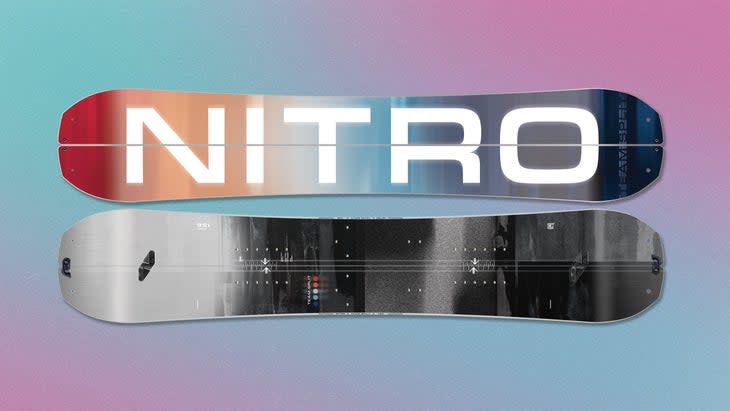
Weight: 7.4 lbs (159)
Sizes: 156cm, 159cm, 162cm
Shape: Directional Twin
Profile: True Camber (standard camber)
Waist Width: 26 (159cm)
Sidecut: 11.7m / 7.3m / 11.7m (159cm)
Our Stiffness Rating: 7/10
Pros:
Affordable price
There are no surprises: it's a classic, cambered all-mountain freestyle snowboard in splitboard form
Did we mention the price?
Cons:
Heavier than options in the next price tier
Not ideal for deep snow, which is what most splitboarders are seeking
Three decades ago, Nitro dropped one of the first splitboards ever made--the Nitro Tour. While a few powder chasers saw utility in the ground-breaking product, the world wasn't ready and it flopped. After a brief hiatus from making split gear, Nitro has renewed its commitment to touring and has been steadily expanding an impressive splitboard range over the last decade. This year, the brand converted a staple solid: the Nitro Team.
Nitro doesn't stamp "Team" on anything their team riders won't actually use and abuse, and the Team Split is no different. The deck is a classic all-mountain snowboard, with a directional twin shape, true camber, and a reliable, meat-and-potatoes build. It's not a powder board by any means. On the contrary, Nitro bills it as "a resort splitboard" built for shredding inbounds one lap and hitting the sidecountry the next. The concept of a resort split is a hard sell, but our testers appreciated the Team Split for a few reasons. The twin shape rides just like a standard cambered snowboard, and excels at popping airs and riding switch. And, the Nitro Team Split is one of the most affordable splits on the market today.
"It's a cambered, twin splitboard for park riders that want to go uphill," says a reformed freestyler who now works as a backcountry guide and tested the Team extensively high in the Eastern Sierra. "This board stomps like a resort board and is perfectly capable as a backcountry jump board." On steeper hardpack, he judged the Team Split reliable, too. "The edge hold was classic camber--on time every time."
To carry the same flex, pop, and ride feel from the solid to the new split--and to make sure the split holds up on the slickest of skintracks--Nitro beefed up the core mid-board and at the contact points. Unsurprisingly given the price tag and construction, our reformed freestyler found the board on the stiff and heavy side. The 159 weighs 7.4 pounds, which is beefy compared to similarly affordable and approachable boards like the lightweight Salomon Highpath ($899 with skins compared to the Nitro at $829 with skins), which weighs 6.6 pounds in the same size. "Felt like a lot to carry around for an all-day tour," he commented.
For riders looking for a more powder-specific shape at the same attractive price point of the Team, another tester pointed to the Nitro Squash as an alternative worth considering. "Splits are expensive as hell, and between the bindings, avalanche safety gear, and education, the barrier to entry is higher than the lines we hope to ride. Both the Team Split and Squash are quality boards for newcomers to get a feel for splitboarding without taking out a second mortgage."
Best for: Resort riders looking to get a foot in the backcountry door without spending an arm and a leg, and freestylers who want a backcountry booter blaster.
Reviews: The Best Splitboard Gear of 2023
K2 Waive ($530)
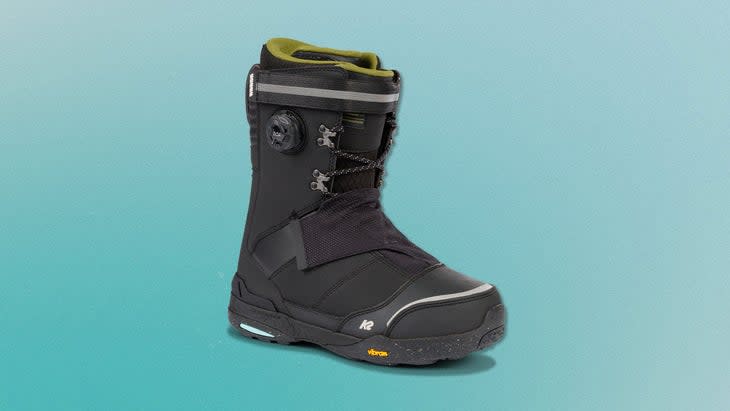
Weight: 5.1 lbs. per pair (9)
Sizes: 6-13
You've probably seen "Splitboarding is the Answer" bumper stickers at your local backcountry trailhead. Well, for softboot diehards who demand a true walk mode, we've got a new bumper sticker for you: "The Waive is the Answer." The slogan may be a work in progress, but this boot is going to make serious waves thanks to its innovative design.
Just pop the BOA dial and release the coiled cable, and a creased section of the synthetic upper around the calf unfurls like an accordion. "It enables a more natural range of motion on the skintrack," said one tester. He wore them on a 12-hour day splitboarding day on Thompson Pass, numerous tours in the Sierra, and bell-to-bell resort days in Utah and California, and never got so much as a blister. The Waive is also more than capable of bootpacking, with its robust, crampon-compatible Vibram outsole and a stiff, rubber-wrapped, step-kicking toe.
On the descent, the same tester was stoked on the mid-stiff flex and the ability to increase response with the Velcro power strap at the shin as needed. "You can wrap the strap tight for puckering lines, or keep it loose for a more forgiving feel." He did have one concern: plastic BOA dials can snap or jam, and they're much harder to fix in the field than laces. Carry a long Voile strap, or two, just in case.
Bottom line: The best touring softboot on the market right now.
Jones Pre-cut Nomad PRO Splitboard Skins ($280)
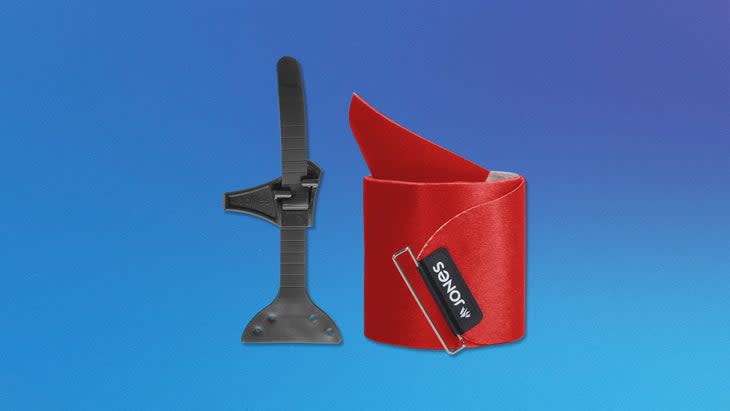
Weight: 1085g/m2.
Size range: Nine pre-cut Quick Tension sizes for Jones splits, three trim-to-fit Quick Tension sizes, and one Universal size
A collaboration between Jones and the Swiss skin experts at Pomoca, the Nomad PRO is a lightweight skin crafted from a blend of 70 percent mohair and 30 percent nylon. Backed with a hydrophobic laminate and treated with both a Bluesign-approved anti-glopping coating and friction-reducing finish for improved glide, these skins are ready to tour the extra mile. "These skins have exceptional glide--what I expect from a premium Pomoca and Jones collab," commented a backcountry regular who was impressed by the thinly cut yet grippy plush. This same tester also gave points for packability: the PRO skins stow to about the size of a roll of toilet paper. "You'll be happy they're so compact when you descend some spicy shit," he said. The skins are available in three iterations: pre-cut with a ready-to-rock tail clip for the notched tails of Jones splits (which we highly recommend), a standard trim-to-fit option in three common sizes with a pre-installed tail clip (you trim to board width and pick between a Jones tail clip or universal version), and a tedious albeit customizable self-install option for boards from all makers, models, and sizes (which we can't be bothered to cut). If a new split gobbled up the bulk of your budget and you want to remake Jeremy Jones' epic splitboard trilogy as Cheaper, Further, Higher (you know, instead of Deeper, Further, Higher), check out Pomoca's more affordable Swiss Army Knife skins: the Climb 2.0.
Bottom line: If you're rocking a Jones split from 2016 or newer with a notched tail, the Quick Tension Nomad Pro is a high-quality, Swiss-made skin with a foolproof tail clip.
G3 Pivot ($161)
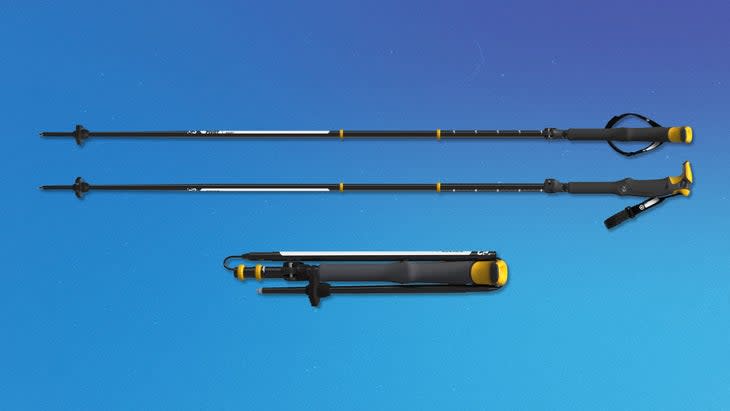
Weight: 10.5 oz per pole (short)
Size range: Short (105-125cm), Long (115-135cm)
Ultralight, carbon poles might be what every splitboarder wants, but durable aluminum poles like G3's Pivot are what every splitboarder needs. Few things are worse than dealing with broken gear deep in the backcountry. "The Pivot's durability is well-worth schlepping a few extra grams," said a tester who recently broke up with carbon poles after snapping one eight miles into a tour. "And besides, the collapsible design makes up for the weight." The three-piece Pivot can be finicky to disengage--the small metal release button is prone to freezing or sticking in negative temps--but once broken down, it folds and wraps around itself. This tester's favorite feature is the sidehill-friendly extended foam grips topped with plastic bills that "make flipping touring risers easier than flipping the pieces of your carbon poles into the bin."
Bottom line: These durable aluminum poles aren't the lightest on the market, but they're built to last. Factor in splitboard-specific grips and a brilliant collapsible design, and the Pivot is hard to beat.
Spark R & D Arc ST ($429)
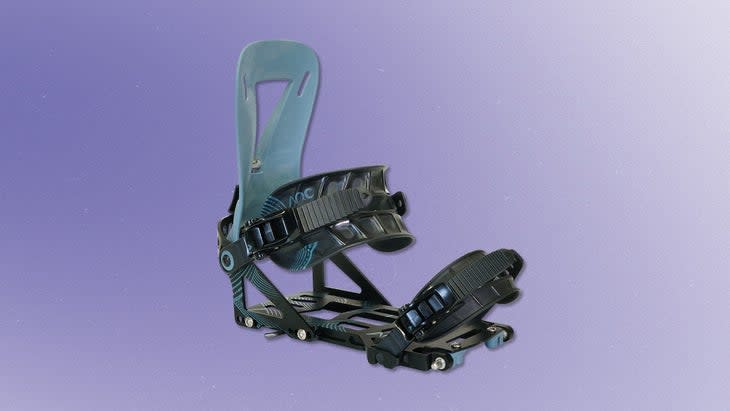
Weight: 1.4 lbs. per binding (M)
Size range: XS-L
We've been fans of Spark's Arc for years thanks to its practical interface, surfy all-mountain ride, and touring chops. But according to one tester who put the Arc ST through the paces all spring, "Spark made a smooth binding smoother." ST stands for "smooth touring" and references a slew of significant updates like more robust touring risers and brackets overmolded with cold-resistant, self-lubricating thermoplastic. "The connection from the binding to the new touring brackets yields noticeably less friction," said our tester. "But I was most stoked on the new touring risers." Spark took the thin wire risers of years' past and wrapped them in the same thermoplastic as the brackets, enlarging catch points and expediting engagement. "With the old models, sometimes you'd have to really crank on 'em, wasting precious seconds on the skin track," said this tester. "The new design is way easier to operate with a quick flick of the pole." Spark also improved downhill performance by adding asymmetry to their highbacks for a more ergonomic, natural stance. Whether you're an entry-level splitter or an experienced backcountry traveler who has no need for a steely, ultra-stiff split binding, the Arc ST is the way to go. New for 2023, Spark is nixing its men's and women's lines in favor of a unisex, boot-length based sizing system. Looking for a stiffer, no-nonsense touring companion? Go with Spark's Surge ST.
Bottom line: Spark's industry-leading interface plus the Arc's tried-and-true, approachable flex and the brand's recent "smooth touring" innovations make the new Arc ST a solid pick for the vast majority of splitboarders.
How to Buy Splitboard Gear
Buying a crappy resort board can result in eternal mediocrity. Buying a crappy split can leave you stranded deep in the backcountry. Here are six tips to keep in mind.
Buy, Don't Build: The DIY split kits that slowly sparked the split revolution are still cheaper than splitboards these days--but not by much. A purpose-built split with inner edges will ride better and last longer than epoxied counterparts. Buy used before you DIY. Or, go the DIY route for fun at your own peril, knowing that you may end up with a garbage product and need to buy a new split anyways.
Budget for Bindings: Split bindings are arguably more critical to your enjoyment than a splitboard. Bindings are the glue that keeps your splitboard together and allow you to transition between touring and riding modes. The saying "a barn door rides well in powder" is true: any modern split will perform decently in excellent conditions, as long as it's sized appropriately (more on that below) and you ride with speed. Old, raggedy bindings, on the other hand, will break down and leave you with nothing but expletives to keep you warm as night falls. Opt for a reputable brand with a proven interface--we recommend Spark R & D's Arc to newcomers and veterans alike.
Quiver Questions: A decade ago, a split quiver was unthinkable for all but a few. As the sport has boomed, riders have expanded their minds--and their board rack--acquiring different splits for different conditions and objectives. Nothing feels better than waking up to a powder day, plucking the right board from the rack, and cruising to the trailhead. But that's not a reality for most splitboarders, especially newcomers. If you're new to the game, start with a quiver-killer. It's more important to have a split that can handle everything decently than one that excels at a specific riding style or terrain type. Don't start thinking about expansion until you fall in love with the sport and put your time in on the skintrack for a season or two. A carbon gun for mach-10 turns in Alaska? Sounds good. A short-fat twin for popping buttery 180s in BC pillow lines? Why not! These boards are fun additions, but they're not what you want when you're just starting out.
Size Smart: Size your main split as you would a freeride board that you expect to take in powder. If you size too small, you'll lose precious float. Size too big, and you'll lose maneuverability. If you're using weight to inform your sizing decisions, remember that you'll be always be wearing a backpack loaded with avalanche safety gear, water, and skins. Don't make it harder than it needs to be. When in doubt, size up a touch. That said, always pay attention to manufacturer recommendations. For instance, Lib Tech's Orca split is meant to be sized three centimeters down from your standard board. One of our testers normally rides a 158 to 160 split, and he found the 156 right on the money. Easy.
Shop for Skins Simultaneously: Many board companies sell skins as an add-on. If they do, jump on it, as the skins will likely be pre-cut to fit your specific board. They can cost a little more than aftermarket options, but they'll save you a headache and ensure the fit is solid--or at least close to solid. If you aren't able to find a set of skins ready-made for your specific splitboard, pay close attention to skin width, length, and tail-clip style when you're on the hunt. Make sure the width of your split is less than the width of the skins. Trim-to-fit skins generally work for a range of sizes. If you're in between sizes, size down for a lighter skin or up for more grip. If you have a funky tail shape-we're looking at you, swallowtails-G3's twin tip kit can be extremely helpful.
Get Educated: After buying your split and before you put it to use, hop on your computer, search for local avalanche classes, and sign up. Do it. Just do it. If you're itching to put your split to the test before you have taken an avalanche safety course, check your local resort: many resorts have uphill travel policies that enable skiers and splitters to tour up maintained, groomed trails. This is a perfect setting to practice your skinning technique and to get a feel for setting up and using your gear without venturing into avalanche terrain. Additionally, many guiding ops offer one-day 101 classes that will introduce you to avalanche safety basics and touring gear. They're a helpful stepping stone if you're intimidated at the thought of jumping straight into an Avalanche Level 1 course.
For exclusive access to all of our fitness, gear, adventure, and travel stories, plus discounts on trips, events, and gear, sign up for Outside+ today.

